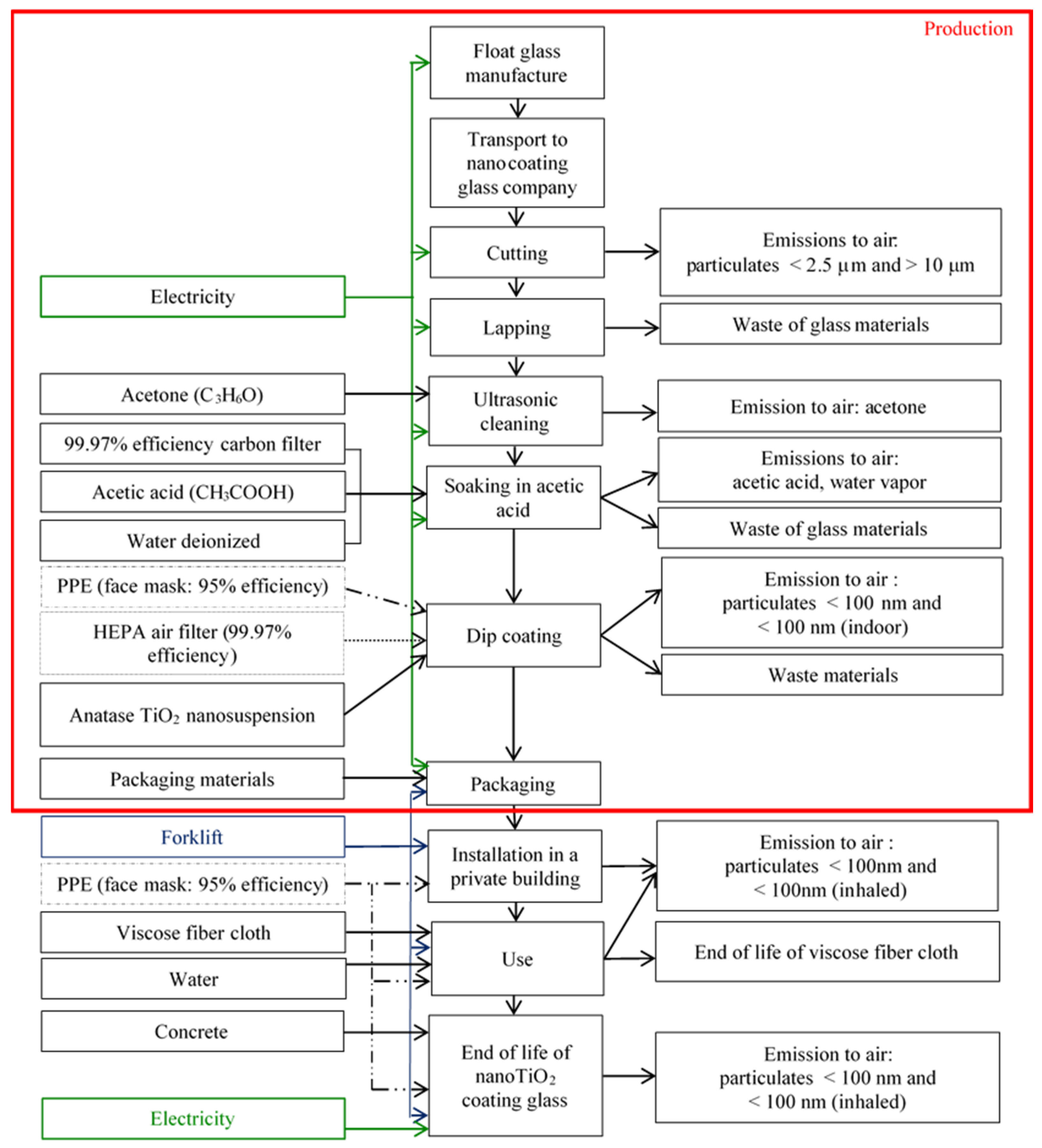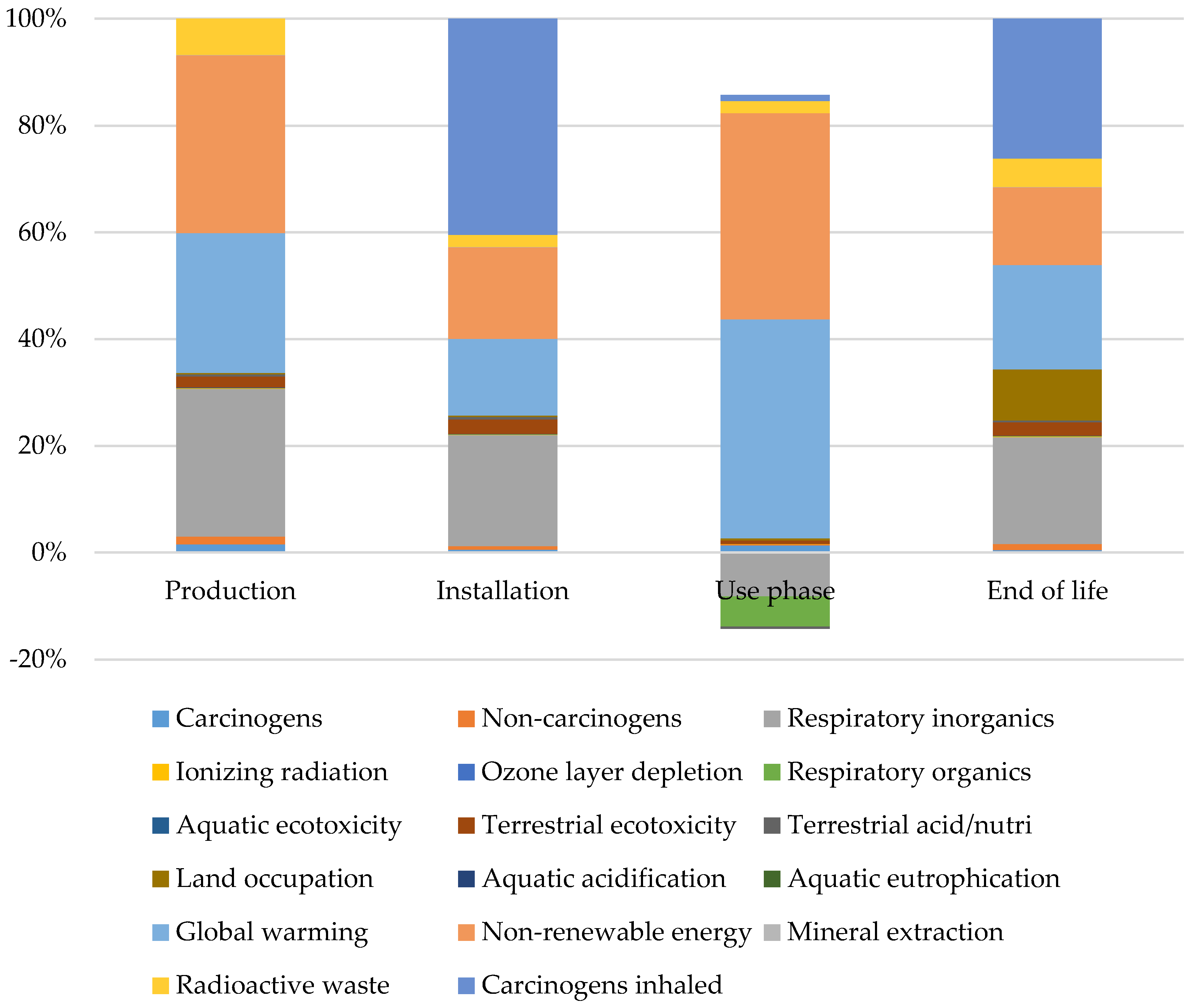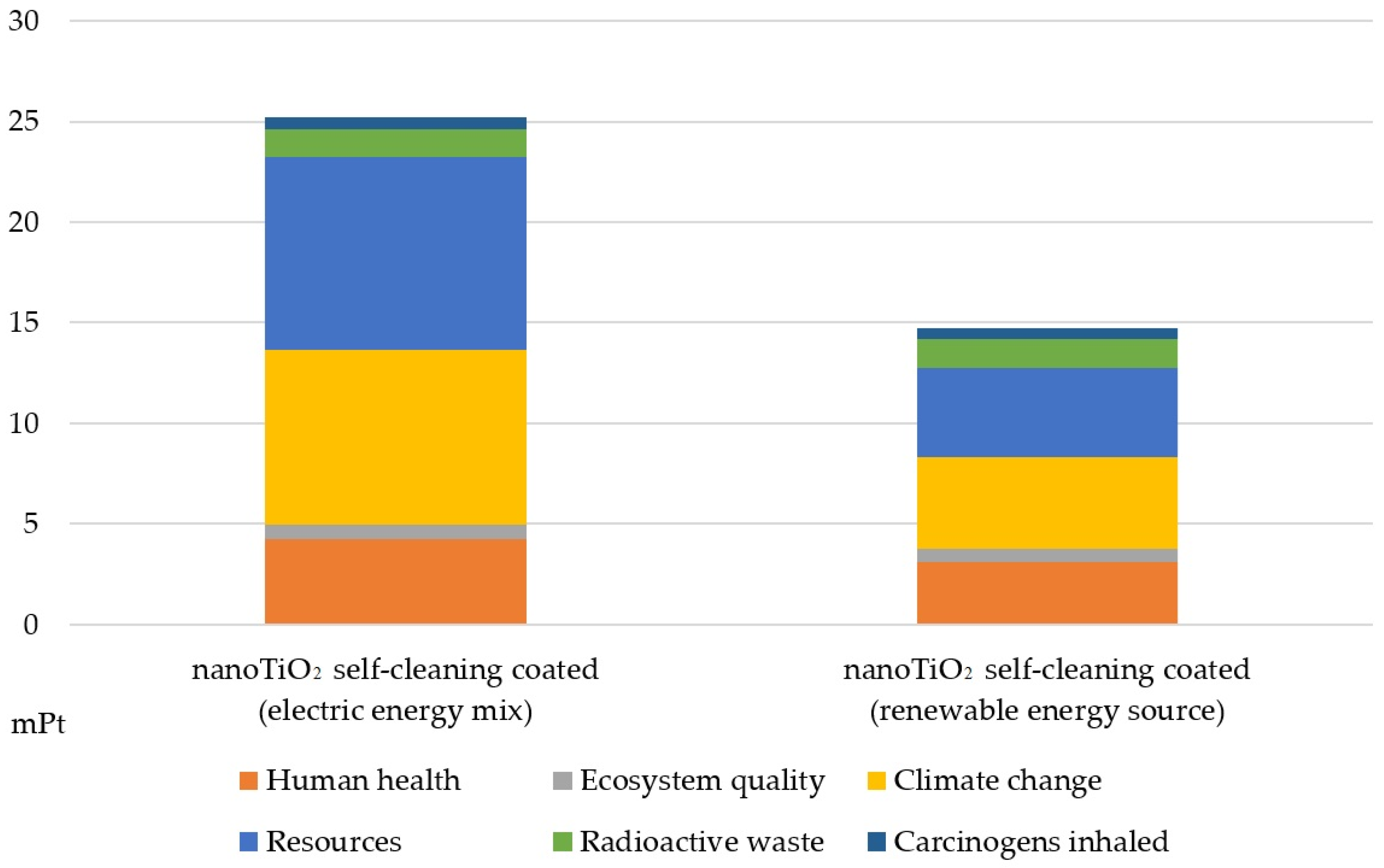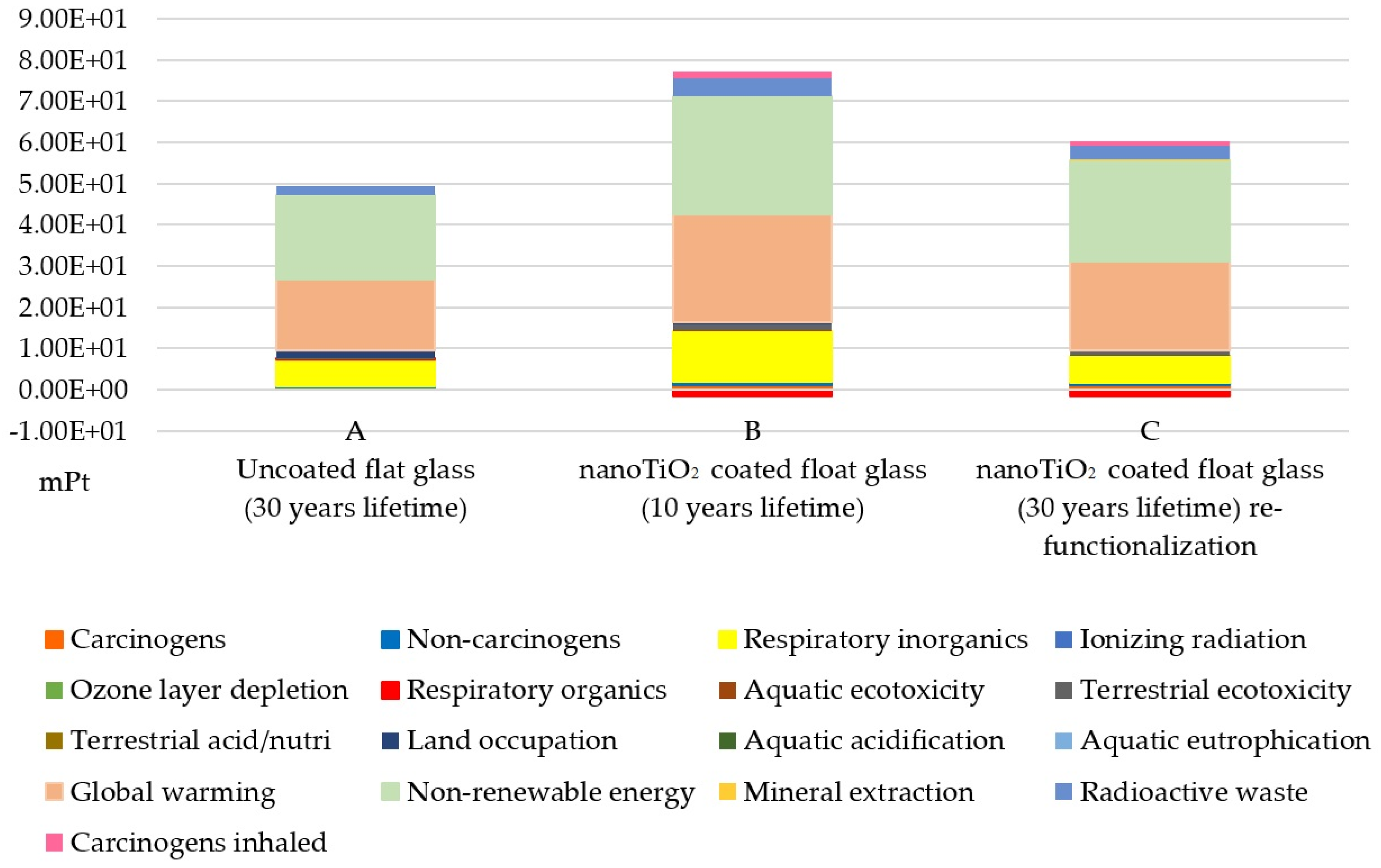Assessment of Environmental Performance of TiO2 Nanoparticles Coated Self-Cleaning Float Glass
Abstract
:1. Introduction
2. Materials and Methods
2.1. Ecodesign of an Industrial Scale Process
- There might be changes due to scale up in process yield as well as in energy efficiency of the process; these can influence the environmental burdens, as these affect the material and energy use as well as the amount of emissions and waste.
- There might be changes in technology and in the material or energy supplies.
- In LCA analysis of pilot/laboratory plants, processes are often seen as isolated or independent from each other. The effects due to changes in plant utilization are not considered sufficiently.
2.2. Goal and Scope Definition
- HEPAs (high efficiency particulate air filters), possessing 99.97% efficiency, were installed during cutting, soaking in acetic acid and coating steps.
- Use of PPE (personal protective equipment), particularly the face mask with its 95% efficiency [44] in protecting workers from dust and nanoparticles inhalation during coating, installation, use and end-of-life steps was implemented.
- A closed manufacturing system was designed.
- Use of specific packaging to limit the release of nanoparticle emissions during transportation was used.
- Transport distances of facilities, raw material, chemicals, materials for packaging from supplier to the production site have been assumed equal to 100 km, as required by the environmental product declaration (EPD) certification [45].
- Italian mixed-electric energy obtained by non-renewable sources (the electricity type mainly used in Italy) and created by ecoinvent was assumed. Obviously, adopting renewable energy such as photovoltaic energy, would enhance the environmental performance. In particular, environmental damage associated with the use of renewable sources can decrease by more than 87%. Nevertheless, this study is part of a regional Italian project, so its production must be located in the Italian territory.
2.3. Impact Assessment
2.4. Life Cycle Inventory
2.4.1. Production
2.4.2. Installation and Use Phase
2.4.3. End of Life
3. Life Cycle Impact Assessment
3.1. The Modified IMPACT 2002+ Method
Effects of Different Electricity Sources
3.2. The Modified USEtox™ Method
3.3. Comparison between the Environmental Performance NanoTiO2 Functionalized Float Glass and the Conventional Ones
- In the Non-renewable energy impact category, case B determines the higher impact (28.7 mPt on the total damage) mainly due to gas, natural, in-ground emission generated by electric energy manufacture in the production process of nanoTiO2 self-cleaning coated float glass;
- In Global warming, case B determines the higher impact (26.09 mPt on the total damage) mainly due to carbon dioxide, fossil emission generated by natural gas production used in the use phase for air conditioning.
- In Respiratory inorganics impact category, case B determines the higher impact (12.2 mPt on the total damage) mainly due to particulates <2.5 μm emission generated by the lapping process in the production stage. For innovative nanomaterials (case studies B and C), nitrogen oxide emissions in the air reduced by the photocatalytic activity of nanoTiO2 coating generated a reduction of environmental load in this category.
4. Conclusions
Supplementary Materials
Acknowledgments
Author Contributions
Conflicts of Interest
References
- Fujishima, A.; Honda, K. Electrochemical photolysis of water at a semiconductor electrode. Nature 1972, 238, 37–38. [Google Scholar] [CrossRef] [PubMed]
- Ni, M.; Leung, M.K.H.; Leung, D.Y.C.; Sumathy, K. A review and recent developments in photocatalytic water-splitting using for hydrogen production. Renew. Sust. Energ. Rev. 2007, 11, 401–425. [Google Scholar] [CrossRef]
- Akhavan, O.; Ghaderi, E. Self-accumulated Ag nanoparticles on mesoporous TiO2 thin film with high bactericidal activities. Surf. Coat. Technol. 2010, 204, 3676–3683. [Google Scholar] [CrossRef]
- Chen, J.; Poon, C. Photocatalytic construction and building materials: From fundamentals to applications. Build. Environ. 2009, 44, 1899–1906. [Google Scholar] [CrossRef]
- Pichat, P. Self-cleaning materials based on solar photocatalysis. In New and Future Developments in Catalysis: Solar Photocatalysis; Suib, S.L., Ed.; Elsevier: Amsterdam, The Netherlands, 2013; pp. 167–190. [Google Scholar]
- Raibeck, L.; Reap, J.; Bras, B. Investigating environmental burdens and benefits of biologically inspired self-cleaning surfaces. CIRP J. Manuf. Sci. Technol. 2009, 1, 230–236. [Google Scholar] [CrossRef]
- Photocatalysts: Technologies and Global Markets; BCC Research Advanced Materials Report AVM069B. Available online: http://www.bccresearch.com/market-research/advanced-materials/photocatalysts-technologies-markets-report-avm069b.html (accessed on 3 September 2016).
- Som, C.; Berges, M.; Chaudhry, Q.; Dusinska, M.; Fernandes, T.F.; Olsen, S.I.; Nowack, B. The importance of life cycle concepts for the development of safe nanoproducts. Toxicology 2010, 269, 160–169. [Google Scholar] [CrossRef] [PubMed]
- Hsu, L.-Y.; Chein, H.-M. Evaluation of nanoparticle emission for TiO2 nanopowder coating materials. In Nanotechnology and Occupational Health; Springer: Berlin, Germany, 2007; pp. 157–163. [Google Scholar]
- United Nations Environment Programme (UNEP). Global Guidance Principles for Life Cycle Assessment Databases. A Basis for Greener Processes and Products; United Nations: Geneva, Switzerland, 2011. [Google Scholar]
- Hischier, R. Framework for LCI modelling of nanoparticle releases along the life cycle. Int. J. LCA 2014, 19, 838–849. [Google Scholar] [CrossRef]
- Hischier, R.; Salieri, B.; Pini, M. Most important factors of variability and uncertainty in an LCA study of nanomaterials – findings from a case study with nano titanium dioxide. IMPACT 2017. Submitted. [Google Scholar]
- Hischier, R.; Walser, T. Life cycle assessment of engineered nanomaterials: State of the art and strategies to overcome existing gap. Sci. Total Environ. 2012, 425, 271–282. [Google Scholar] [CrossRef] [PubMed]
- Gavankar, S.; Suh, S.; Keller, A.F. Life cycle assessment at nanoscale: Review and recommendations. Int. J. LCA 2012, 17, 295–303. [Google Scholar] [CrossRef]
- Gavankar, S.; Suh, S.; Keller, A.A. Life Cycle Assessment of Engineered Nanomaterials; Woodhead Publishing: Cambridge, UK, 2014. [Google Scholar]
- Upadhyayula, V.K.K.; Meyer, D.E.; Curran, M.A.; Gonzalez, M.A. Life cycle assessment as a tool to enhance the environmental performance of carbon nanotube products: A review. J. Clean Prod. 2012, 26, 37–47. [Google Scholar] [CrossRef]
- Kim, H.C.; Fthenakis, V. Life cycle energy and climate change implications of nanotechnologies. A critical review. J. Ind. Ecol. 2013, 17, 528–541. [Google Scholar] [CrossRef]
- Lazarevic, D.; Finnveden, G. Life cycle aspects of nanomaterials. In Environmental Strategies Research KTH; Royal Institute of Technology: Stockholm, Sweden, 2013. [Google Scholar]
- Miseljic, M.; Olsen, S.I. Life-cycle assessment of engineered nanomaterials: A literature review of assessment status. J. Nanopart. Res. 2014, 16, 1–33. [Google Scholar] [CrossRef]
- Eckelman, M.J.; Mauter, M.S.; Isaacs, J.A.; Elimelech, M. New perspectives on nanomaterial aquatic ecotoxicity: Production impacts exceed direct exposure impacts for carbon nanotoubes. Environ. Sci. Technol. 2012, 46, 2902–2910. [Google Scholar] [CrossRef] [PubMed]
- Deng, Y.; Li, J.; Qiu, M.; Yang, F.; Zhang, J.; Yuan, C. Deriving characterization factors on freshwater ecotoxicity of graphene oxide nanomaterial for life cycle impact assessment. Int. J. LCA 2016. [Google Scholar] [CrossRef]
- Salieri, B.; Righi, S.; Pasteris, A.; Olsen, S.I. Freshwater ecotoxicity characterisation factor for metal oxide nanoparticles: A case study on titanium dioxide nanoparticle. Sci. Total Environ. 2015, 505, 494–502. [Google Scholar] [CrossRef] [PubMed] [Green Version]
- Pini, M.; Salieri, B.; Ferrari, A.M.; Nowack, B.; Hischier, R. Human health characterization factors of nano-TiO2 for indoor and outdoor environments. Int. J. LCA 2016, 21, 1452–1462. [Google Scholar] [CrossRef]
- Pini, M. Life Cycle Assessment of Nano-TiO2 Functionalized Building Materials Extended to Historical Buildings. Ph.D. Thesis, University of Modena and Reggio Emilia, Modena, Italy, 2015. [Google Scholar]
- Bando “Dai Distretti Produttivi ai Distretti Tecnologici”—DGR n. 1631/2009. Available online: http://www.innovazionefinanza.it/2009/emilia-romagna-distretti-tecnologici/ (accessed on 9 January 2017).
- Ferrari, A.M.; Pini, M.; Neri, P.; Bondioli, F. Nano-TiO2 coatings for limestone: Which sustainability for cultural heritage? Coatings 2015, 5, 232–245. [Google Scholar] [CrossRef] [Green Version]
- Pini, M.; Gamberini, R.; Neri, P.; Rimini, B.; Ferrari, A.M. Life Cycle Assessment of a Self-Cleaning Coating Based on NanoTiO2-Polyurea Resin Applied on an Aluminum Panel. Available online: http://digidownload.libero.it/giabon/tesi/pini/pres_pini_LCAResinaPoliurea_con_nanoTiO2.pdf (accessed on 9 January 2017).
- Pini, M.; Bondioli, F.; Neri, P.; Montecchi, R.; Ferrari, A.M. Environmental and human health assessment of life cycle of nanoTiO2 functionalized porcelain stoneware tile. Sci. Total Environ. 2017, 577, 113–121. [Google Scholar] [CrossRef] [PubMed]
- Pini, M.; Rosa, R.; Neri, P.; Bondioli, F.; Ferrari, A.M. Environmental assessment of a bottom-up hydrolytic synthesis of TiO2 nanoparticles. Green Chem. 2015, 17, 518–531. [Google Scholar] [CrossRef]
- Pini, M.; Marinelli, S.; Gamberini, R.; Neri, P.; Rimini, B.; Ferrari, A.M. Life cycle assessment of a nano-TiO2 functionalized enamel applied on a steel panel. IJOQM 2016, 12, 478–485. [Google Scholar]
- Walser, T.; Demou, E.; Lang, D.J.; Hellweg, S. Prospective environmental life cycle assessment of nanosilver T-shirts. Environ. Sci. Technol. 2011, 45, 4570–4578. [Google Scholar] [CrossRef] [PubMed]
- Hischier, R. Life cycle assessment study of a field emission display television device. Int. J. LCA 2015, 20, 61–73. [Google Scholar] [CrossRef]
- Roes, A.L.; Tabak, L.B.; Shen, L.; Nieuwlaar, E.; Patel, M.K. Influence of using nanoobjects as filler on funtionality-based energy use of nanocomposites. J. Nanopart. Res. 2010, 12, 2011–2028. [Google Scholar] [CrossRef]
- Cedillo-González, E.I.; Montorsi, M.; Mugoni, C.; Montorsi, M.; Siligardi, C. Improvement of the adhesion between TiO2 nanofilm and glass substrate by roughness modifications. Phys. Procedia 2013, 40, 19–29. [Google Scholar] [CrossRef]
- Shibasaki, M.; Warburg, N.; Eyerer, P. Upscaling effect and life cycle assessment. In Proceedings of the 13th CIRP International Conference on Life Cycle Engineering, Leuven, Belgium, 31 May–2 June 2006.
- Gavankar, S.; Suh, S.; Keller, A.A. The role of scale and technology maturity in life cycle assessment of emerging technologies—A case study on carbon nanotubes. J. Ind. Ecol. 2015, 19, 51–60. [Google Scholar] [CrossRef]
- Caduff, M.; Huijbregts, M.A.J.; Althaus, H.-J.; Koehler, A.; Hellweg, S. Wind power electricity: The bigger the turbine, the greener the electricity? Environ. Sci. Technol. 2012, 46, 4725–4733. [Google Scholar] [CrossRef] [PubMed]
- Arvidsson, R.; Kushnir, D.; Molander, S.; Sandén, B.A. Energy and resource use assessment of graphene as a substitute for indium tin oxide in transparent electrodes. J. Clean. Prod. 2016, 132, 289–297. [Google Scholar] [CrossRef]
- Li, Q.; McGinnis, S.; Sydnor, C.; Wong, A.; Renneckar, S. Nanocellulose life cycle assessment. ACS Sustain. Chem. Eng. 2013, 1, 919–928. [Google Scholar] [CrossRef]
- Product Ecology Consultants (PRè). SimaPro database manual—Methods library. Available online: http://discounthardware.us/read-online/download-now/simapro-database-manual-methods-library.pdf (accessed on 4 January 2017).
- Life Cycle Inventories, Ecoinvent Database v. 2.0. Available online: http://www.ecoinvent.ch (accessed on 12 December 2010).
- Demeestere, K.; Dewulf, J.; De Witte, B.; Beeldens, A.; Van Langenhove, H. Heterogeneous photocatalytic removal of toluene from air on building materials enriched with TiO2. Build. Environ. 2008, 43, 406–414. [Google Scholar] [CrossRef]
- Klöpffer, W.; Curran, M.A.; Frankl, P.; Heijungs, R.; Köhler, A.; Olsen, S.I. Nanotechnology and Life Cycle Assessment. A Systems Approach to Nanotechnology and the Environment. In Proceedings of the Nanotechnology and Life Cycle Assessment Workshop, Washington, DC, USA, 2–3 October 2006.
- BS EN 149:2001+A1:2009 Respiratory Protective Devices. Filtering Half Masks to Protect against Particles. Requirements, Testing, Marking; British Standards Institution (BSI): London, UK, 2011.
- General Programme Instructions for Environmental Product Declarations EPD, the International EPD Cooperation, version 1.0. Available online: http://www.environdec.com/en/The-International-EPD-System/General-Programme-Instructions/ (accessed on 9 January 2017).
- Jolliet, O.; Margni, M.; Charles, R.; Humbert, S.; Payet, J.; Rebitzer, G.; Rosenbaum, R. IMPACT2002+: A new life cycle impact assessment methodology. Int. J. LCA 2003, 8, 324–330. [Google Scholar] [CrossRef]
- USEtox™ (2016), User Manual. Available online: http://www.usetox.org/support/tutorials-manuals (accessed on 23 March 2016).
- Baldi, G.; Bitossi, M.; Barzanti, A. Method for the Preparation of Aqueous Dispersions of TiO2 in the Form of Nanoparticles, and Dispersions Obtainable with This Method. U.S. Patent 20080317959A1, 25 December 2008. [Google Scholar]
- Fujishima, A.; Rao, T.N.; Tryk, D.A. Titanium dioxide photocatalysis. J. Photoch. Photobio. C 2000, 1, 1–21. [Google Scholar] [CrossRef]
- IGEL (Initiative for Global Environmental Leadership), Making the Transition to a Low-Carbon Economy. Available online: http://knowledge.wharton.upenn.edu/special-report/making-the-transition-to-a-low-carbon-economy/ (accessed on 20 December 2016).






| Category | Components | Quantity | Unit | Source |
|---|---|---|---|---|
| Energy input | Electricity consumption | 244.4 | kWh | Energetic process I/O data derived from ecoinvent database. Energy consumptions were supplied by the chemical lab and scaled up with linear rate |
| Materials I/O | Float glass uncoated | 9.91 | kg | Data supplied by the chemical lab and scaled up with linear rate and Colorobbia Italia SpA. for nanoTiO2 suspension |
| Tap water | 52.77 | L | ||
| Acetone | 263.33 | kg | ||
| Acetic acid | 4.37 | kg | ||
| Water deionized | 2.39 | kg | ||
| Compressed air | 423.33 | L | ||
| nanoTiO2 suspension | 5.84E−03 | kg | ||
| Protection film (LDPE) | 1.92E−02 | kg | Data was supplied by one of the company leaders in glass production | |
| Viscose fiber cloth | 0.13 | kg | ||
| Concrete | 0.24 | m3 | ||
| Heat gain in summer season due to nanocoating | 825.2 | kW | Data supplied by the chemical lab and scaled up with linear rate | |
| Heat lost in winter season due to nanocoating | 754.13333 | kW | ||
| Emissions to air | Particulates <2.5 µm | 1.43E−02 | kg | Data supplied by the chemical lab and scaled up with linear rate |
| Particulates >10 µm | 2.61E−02 | kg | ||
| Particulates >2.5 µm and <10 µm | 6.53 | kg | ||
| Acetic acid | 7.20E−02 | kg | ||
| Water | 1.29E−02 | kg | ||
| Acetone | 3.31E−06 | kg | ||
| Particulates <100 nm in air | 6.67E−03 | kg | ||
| Particulates <100 nm inhaled | 0.75 | kg | ||
| NOx | 1.17E−01 | kg | ||
| Nitric acid | 2.40E−04 | kg | ||
| Toluene | 92E−03 | kg | ||
| CO2 | 3.92E−02 | kg | ||
| Transports | Road | 85.49 | tkm | |
| Waste to treatment | Disposal to residual landfill of nanoTiO2 particulates captured by filter | 4.01E−04 | g | Waste quantities were given from the chemical lab while waste treatment statistics were derived from the ecoinvent process |
| Acetone wastes captured by filter to residual landfill | 5.05E−03 | cm3 | ||
| Acetic acid wastes captured by filter to residual landfill | 4.33 | kg | ||
| Wastewater treatment (water used during the maintenance operations of equipment) | 52.77 | L | ||
| Disposal of particulates <2.5 µm and >10 µm dust captured by filter to residual landfill | 1248.21 | g | ||
| Disposal waste glass (inertization) | 8.04 | kg | End of life of functionalized glass was built ad hoc according to ecodesign approach. Data were appropriately assumed |
| Impact Category | Unit | Total | Production | Installation | Use Phase | End of Life |
|---|---|---|---|---|---|---|
| Carcinogens | kg C2H3Cl eq | 6.35E−01 | 2.33E−03 | 3.37E−01 | 1.99E−02 | 6.35E−01 |
| Non-carcinogens | kg C2H3Cl eq | 6.14E−01 | 3.02E−03 | 5.15E−02 | 4.30E−02 | 6.14E−01 |
| Respiratory inorganics | kg PM2.5 eq | 4.60E−02 | 3.58E−04 | −8.27E−03 | 3.11E−03 | 4.60E−02 |
| Ionizing radiation | Bq C-14 eq | 8.20E+02 | 4.17E+00 | 1.88E+02 | 6.35E+01 | 8.20E+02 |
| Ozone layer depletion | kg CFC-11 eq | 7.75E−06 | 1.01E−07 | 6.14E−06 | 3.51E−07 | 7.75E−06 |
| Respiratory organics | kg C2H4 eq | 2.13E−02 | 2.78E−04 | −1.86E+00 | 2.69E−03 | 2.13E−02 |
| Aquatic ecotoxicity | kg TEG water | 5.46E+03 | 3.58E+01 | 9.13E+02 | 2.31E+02 | 5.46E+03 |
| Terrestrial ecotoxicity | kg TEG soil | 5.88E+02 | 8.05E+00 | 1.10E+02 | 6.83E+01 | 5.88E+02 |
| Terrestrial acid/nutri | kg SO2 eq | 7.76E−01 | 9.62E−03 | −4.79E−01 | 6.78E−02 | 7.76E−01 |
| Land occupation | m2org.arable | 5.31E−01 | 5.64E−03 | 5.08E−01 | 1.84E+00 | 5.31E−01 |
| Aquatic acidification | kg SO2 eq | 2.29E−01 | 1.62E−03 | 8.40E−02 | 1.24E−02 | 2.29E−01 |
| Aquatic eutrophication | kg PO4 P-lim | 7.15E−03 | 2.69E−05 | 1.58E−03 | 3.43E−04 | 7.15E−03 |
| Global warming | kg CO2 eq | 4.26E+01 | 2.43E−01 | 4.03E+01 | 2.97E+00 | 4.26E+01 |
| Non-renewable energy | MJ primary | 8.31E+02 | 4.44E+00 | 5.83E+02 | 3.39E+01 | 8.31E+02 |
| Mineral extraction | MJ surplus | 2.87E+00 | 5.98E−03 | 1.89E−01 | 8.30E−02 | 2.87E+00 |
| Radioactive waste | kg | 3.76E+01 | 1.73E−01 | 7.59E+00 | 6.47E+01 | 3.76E+01 |
| Carcinogens inhaled | kg | 1.10E−03 | 3.82E−06 | 2.23E−04 | 8.17E−05 | 1.10E−03 |
| Total | mPt (milli-point) | 2.522E+01 | 1.641E+01 | 1.700E−01 | 7.100E+00 | 1.534E+00 |
| Damage Category | Unit | Total | Production | Installation | Use Phase | End of Life |
|---|---|---|---|---|---|---|
| Human health | DALY | 2.99E−05 | 3.59E−05 | 2.67E−07 | −8.61E−06 | 2.37E−06 |
| Ecosystem quality | PDF·m2·year | 9.99E+00 | 6.31E+00 | 8.17E−02 | 9.72E−01 | 2.63E+00 |
| Climate change | kg CO2 eq | 8.61E+01 | 4.26E+01 | 2.43E−01 | 4.03E+01 | 2.97E+00 |
| Resources | MJ primary | 1.46E+03 | 8.34E+02 | 4.44E+00 | 5.83E+02 | 3.40E+01 |
| Radioactive waste | kg | 1.10E+02 | 3.76E+01 | 1.73E−01 | 7.59E+00 | 6.47E+01 |
| Carcinogens inhaled | DALY | 1.41E−03 | 1.10E−03 | 3.82E−06 | 2.23E−04 | 8.17E−05 |
| Impact Category | Unit | NanoTiO2 Self-Cleaning Coated (Electric Energy Mix) | NanoTiO2 Self-Cleaning Coated (Renewable Energy Source) |
|---|---|---|---|
| Carcinogens | kg C2H3Cl eq | 9.95E−01 | 7.36E−01 |
| Non-carcinogens | kg C2H3Cl eq | 7.11E−01 | 8.78E−01 |
| Respiratory inorganics | kg PM2.5 eq | 4.12E−02 | 3.04E−02 |
| Ionizing radiation | Bq C-14 eq | 1.08E+03 | 1.08E+03 |
| Ozone layer depletion | kg CFC-11 eq | 1.43E−05 | 8.42E−06 |
| Respiratory organics | kg C2H4 eq | −1.83E+00 | −1.84E+00 |
| Aquatic ecotoxicity | kg TEG water | 6.64E+03 | 6.37E+03 |
| Terrestrial ecotoxicity | kg TEG soil | 7.75E+02 | 7.46E+02 |
| Terrestrial acid/nutri | kg SO2 eq | 3.74E−01 | 7.79E−02 |
| Land occupation | m2org.arable | 2.89E+00 | 2.69E+00 |
| Aquatic acidification | kg SO2 eq | 3.27E−01 | 2.40E−01 |
| Aquatic eutrophication | kg PO4 P-lim | 9.11E−03 | 1.14E−02 |
| Global warming | kg CO2 eq | 8.61E+01 | 4.45E+01 |
| Non-renewable energy | MJ primary | 1.45E+03 | 6.76E+02 |
| Mineral extraction | MJ surplus | 3.15E+00 | 3.89E+00 |
| Renewable energy | MJ | 1.10E+02 | 6.87E+02 |
| Radioactive waste | kg | 1.41E−03 | 1.40E−03 |
| Carcinogens inhaled | kg | 7.45E−07 | 7.45E−07 |
| Total | mPt (milli-point) | 2.522E+01 | 1.475E+01 |
| Impact Category | Unit | Total | Production | Installation | Use Phase | End of Life |
|---|---|---|---|---|---|---|
| Human toxicity, cancer | CTUh # | 4.401E−06 | 3.692E−06 | 1.497E−08 | 5.65E−07 | 1.297E−07 |
| Human toxicity, non-cancer | CTUh # | 1.565E−07 | 1.261E−07 | 6.657E−10 | 2.297E−08 | 6.797E−09 |
| Ecotoxicity | CTUe § | 46.236702 | 38.666071 | 0.1488913 | 6.0468404 | 1.3748995 |
| Human toxicity, cancer, indoor | CTUh # | 1.066E−08 | 6.344E−14 | 1.256E−09 | 2.073E−09 | 7.327E−09 |
| Human toxicity, non-cancer, indoor | CTUh # | 4.359E−13 | 2.595E−18 | 5.139E−14 | 8.479E−14 | 2.997E−13 |
© 2017 by the authors; licensee MDPI, Basel, Switzerland. This article is an open access article distributed under the terms and conditions of the Creative Commons Attribution (CC-BY) license (http://creativecommons.org/licenses/by/4.0/).
Share and Cite
Pini, M.; Cedillo González, E.I.; Neri, P.; Siligardi, C.; Ferrari, A.M. Assessment of Environmental Performance of TiO2 Nanoparticles Coated Self-Cleaning Float Glass. Coatings 2017, 7, 8. https://doi.org/10.3390/coatings7010008
Pini M, Cedillo González EI, Neri P, Siligardi C, Ferrari AM. Assessment of Environmental Performance of TiO2 Nanoparticles Coated Self-Cleaning Float Glass. Coatings. 2017; 7(1):8. https://doi.org/10.3390/coatings7010008
Chicago/Turabian StylePini, Martina, Erika Iveth Cedillo González, Paolo Neri, Cristina Siligardi, and Anna Maria Ferrari. 2017. "Assessment of Environmental Performance of TiO2 Nanoparticles Coated Self-Cleaning Float Glass" Coatings 7, no. 1: 8. https://doi.org/10.3390/coatings7010008







